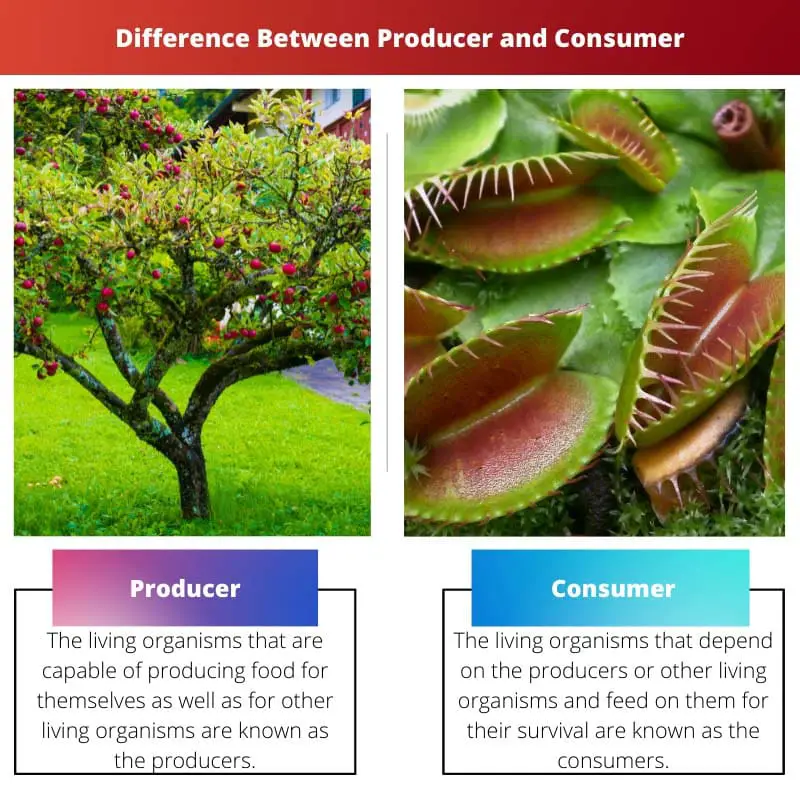There exist several living beings and natural resources in the surroundings. There exist several ecosystems, food chains, and abiotic and biotic factors in nature.
In order to keep an equilibrium between all living organisms, there are certain food chains that are present in nature. There are food chains between animals and plants as well.
Various living organisms depend on each other for their survival. These food chains have several levels and stages in them. Various animals play the role of being at these stages.
These trophic levels include primary producers, primary consumers, secondary consumers, tertiary consumers and quaternary consumers. These trophic levels consist of different animals. Various animals perform their roles at different trophic levels.
Key Takeaways
- A producer is a person or a company that creates and supplies goods or services to the market.
- On the other hand, a consumer is a person or entity that uses or consumes the goods and services provided by the producers.
- Producers are the suppliers, while consumers are the end-users of goods and services.
Producer vs Consumer
The difference between producers and consumers is the role that they play at their respective trophic levels. The producers play an important role in producing food for themselves as well as for others. On the other hand, the consumers do not produce their food or anything in general. Consumers gain energy by feeding on other living organisms.

The living organisms that are capable of producing food for themselves as well as for other living organisms, are known as the producers. They are the first trophic level in the respective food chain.
They serve as a food source for many other consumers and also for various trophic levels. The base of the food chain is formed primarily by the producers.
The living organisms that depend on the producers or other living organisms and feed on them for their survival are known as the consumers. Consumers gain their energy from other living organisms. The consumers are either predators or parasites.
They can be either meat-eating or parasites that live in or on the host. However, there are examples of some producers that are classified as consumers as well. Venus Flytrap plants are one of these types.
Comparison Table
| Parameters of Comparison | Producer | Consumer |
|---|---|---|
| Meaning/ Definition | The living organisms that are capable of producing food for themselves as well as for other living organisms are known as the producers. | The living organisms that depend on the producers or other living organisms and feed on them for their survival are known as the consumers. |
| Trophic level | Producers occupy the first trophic level. | Consumers occupy the other trophic levels. |
| Survival | Producers make their food for their survival. | Consumers feed on other living organisms or producers for their survival. |
| Also known as | Converters, transducers | Obtainers |
| Examples | Plants, algae, phytoplankton, chemosynthetic bacteria, grass etc. | Giraffes, pandas, elephants, rabbits, bears etc. |
What is Producer?
The living organisms that are capable of producing food for themselves as well as for other living organisms, are known as the producers. They gain their energy by making their food on their own.
They do not depend on other living beings for their survival. They are plants. There are several other examples of producers as well.
They are the first trophic level in the respective food chain. They serve as a food source for many other consumers and also for various trophic levels. The base of the food chain is formed primarily by the producers.
However, there are examples of some producers that are classified as consumers as well. Venus Flytrap plants are one of these types.
They are autotrophic. Producers can also convert inorganic substances into organic ones. They also help in forming the base of the respective food chain.
The other names by which the producers are acknowledged include transducers and converters. The plants that are the producers in the food chain perform photosynthesis.
Various examples of producers include green plants, small shrubs, fruits, phytoplankton, algae, chemosynthetic bacteria, protests, cyanobacteria etc.
Producers play an important role in the food chain as they play an important role by supplying food to other living organisms. Consumers depend on producers for their survival as they eat the producers.

What is Consumer?
The living organisms that depend on the producers or other living organisms and feed on them for their survival are known as the consumers.
They gain their energy by feeding on producers and other living organisms. They can be either predators or parasites that live in or on the host.
Consumers can be either meat-eating or parasites that live in or on the host. However, there are examples of some producers that are classified as consumers as well. Venus Flytrap plants are one of these types.
Consumers are heterotrophs. They can not convert inorganic substances into organic ones like producers.
Unlike producers, consumers play a secondary role in the respective food chain. Other trophic levels, except for the first trophic level, are occupied by the consumers.
They can not perform photosynthesis like producers, and they can not synthesise food by means of solar energy. There are several other characteristic features of consumers.
Various examples of consumers include grasshoppers, frogs, giraffes, pandas, elephants, rabbits, bears, deer, zebra, lions, goats, cows, butterflies, wolves, snakes, bats, eagles, hens, owls, fishers, rats, flies, humans, horses, termites, hummingbirds, insects, caterpillars, crocodiles, piranhas, pufferfish, dogs, cats, moles, polar bears, turtles, sharks whales, tuna, barracuda, spiders, seals, etc.

Main Differences Between Producer and Consumer
- The producers play an important role in producing food for themselves as well as for others. On the other hand, the consumers do not produce their food or anything in general.
- The producers gain their energy by preparing their food and performing photosynthesis for their survival. On the other hand, the consumers gain their energy by feeding on producers and other living organisms.
- The producers are primarily autotrophic. On the other hand, the consumers are primarily heterotrophic.
- The producers occupy the first trophic level in the respective food chain. On the other hand, the consumers occupy the other trophic levels of the respective food chain.
- Other names by which the producers are acknowledged include transducers and converters. On the other hand, the consumers are also known as the containers.
- Examples of producers include green plants, algae, bacteria, phytoplankton etc., on the other hand, the examples of consumers include bears, lions, zebra, deer, snakes etc.

- https://books.google.com/books?hl=en&lr=&id=epykDwAAQBAJ&oi=fnd&pg=PP5&dq=producers+in+food+chain&ots=6BGCjbnKdq&sig=KDjM0SC8zSkAYatEWkG9EG9-5xw
- https://www.publish.csiro.au/mf/mf08240

The comparison table and descriptions of producers and consumers offer a comprehensive insight into the dynamics of food chains and trophic levels, providing a valuable resource for understanding ecological concepts.
The differentiation between producers and consumers allows for a better understanding of their contributions to ecological sustainability.
The examples provided for both producers and consumers enhance the understanding of their roles in ecosystems.
The article provides a comprehensive overview of the role of producers and consumers in ecosystems and food chains. It’s a great read for anyone interested in biology and environmental science.
The article presents a comprehensive analysis of the roles of producers and consumers in ecosystems, elucidating the intricate relationships within food chains and trophic levels.
The comparison between producers and consumers offers a clear understanding of their roles in ecosystem sustainability.
The section on the different trophic levels and their significance in energy transfer was very insightful.
The article effectively conveys the intricate relationships between producers and consumers, and their vital roles in supporting ecosystems.
The mention of Venus Flytrap plants as producers that are also classified as consumers was a fascinating insight.
The detailed description of the roles and functions of producers and consumers contributes to a deeper understanding of ecological processes and relationships within ecosystems.
The article effectively captures the interconnectedness and interdependence of living organisms within ecosystems.
The article effectively emphasizes the pivotal roles of producers and consumers in maintaining the ecological balance and energy flow within ecosystems.
The article provides a thorough overview of the concepts of producers and consumers, highlighting their significance in ecology.
An informative and detailed exploration of producers and consumers, shedding light on their vital roles in ecosystem dynamics.
The article effectively portrays the significance of producers and consumers in maintaining the delicate balance of ecosystems through food chains and trophic levels.
The section discussing autotrophic nature of producers and their role in forming the base of food chains was very informative.
A very insightful article explaining the importance of producers and consumers in maintaining the balance of nature by sustaining various trophic levels.
The explanation of trophic levels and how different organisms play their roles in the food chain is very well articulated.
I particularly found the comparison table very useful in understanding the differences between producers and consumers.
The comparison of producers and consumers, along with their respective functions and examples, provides a clearer understanding of their roles in nature’s processes.
The way energy flow is depicted from producers to consumers in the food chain is well explained.
The differentiation between producers and consumers is clearly explained, shedding light on their significance in maintaining ecological balance.
I appreciated the examples provided to illustrate the concepts of producers and consumers.
The section on the role of producers as the base of the food chain was particularly enlightening.